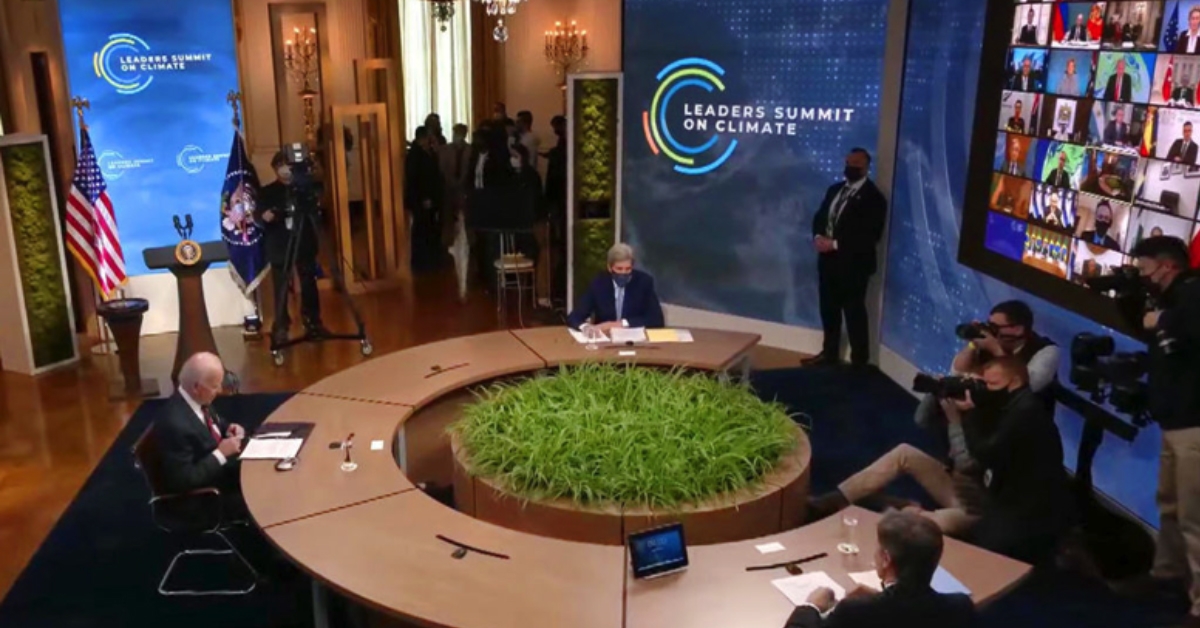From President Joe Biden dropping his new national climate target to climate activists dropping…well…droppings outside the White House in protest of his climate plan, Earth Day was eventful to say the least.
Held on April 22, the virtual climate summit saw lofty declarations made by 40 global leaders. Mr Biden – accompanied by Antony Blinken and John Kerry, the US secretary of state and climate envoy, respectively – sat socially-distanced at a desk curved around a patch of grass that looked oddly placed.
US vows to cut half its emissions.
During the summit, Biden pledged to cut US carbon emission by 50-52% below 2005 levels by 2030, as USA aims for net zero emissions by 2050. That’s almost twice the reduction promised by Barack Obama in 2015 (which was later withdrawn by the Trump administration).
He urged that the US going zero alone won’t be sufficient as almost 90% of the planet’s emissions come from outside of US borders. He was met with an almost universal response from the summit global leaders: “It won’t be an easy task”.
As if external resistance isn’t enough, we can anticipate that Biden’s ambitious climate target will face much internal opposition as well. How much can the Biden administration achieve given Republican reluctance to environmental policy in Congress?
Lacking specifics for his radical plan, his administration is expected to lay out a clear road map to its carbon-free destination very soon, but the cloud of doubt remains hanging overhead – will he be able to influence his global counterparts to do the same?
Putting the US back on the table of influence.
Biden promises to make the US the leader in the climate fight and will try to convince the rest of the world to follow suit, but it will be a tough sell nonetheless. In a visit to Shanghai prior to the climate summit, Mr Kerry’s attempt to urge that climate be a “stand-alone” issue was shrugged off by some Chinese environmental policy analysts. They were adamant that climate is inextricable from debates over geopolitical influence, intellectual property or industrial policy.
In a bid to spur other major economies to take bolder steps, Biden took the opportunity to tell world leaders:
“Your leadership on this issue is a statement to the people of your nation and to the people of every nation, especially our young people, that we’re ready to meet this moment […] We really have no choice. We have to get this done.”
The scientific consensus on climate change is clear and irrefutable – anthropogenic impacts on the climate have unravelled a series of ravaging events, which will only increase in severity and frequency if drastic but practical climate and sustainability actions are not deployed within this decade. The faster countries – particularly those emitting the most carbon – act on the climate crisis, the less they’ll need to spend in the future in order to deal with its repercussions. Currently, the world is lagging far behind its target for climate emissions.
A collective global effort
As emphasised by Biden, the rest of the world is responsible for about 85% of all emissions. Only through a coordinated, determined international effort will humanity avert the devastation of the climate crisis.
Cutting emissions by half within a decade suggests transforming the electricity system, transportation, industry and agriculture. Setting these goals is the easy part. Akin to the saying Rome wasn’t built in a day, this too, will be a tall order combining technical feasibility and political palatability – the tough part is getting it done.
All eyes will be on Biden as he tries to restore US credibility after the Trump administration undermined the climate efforts of its predecessors. With plenty of domestic work on climate still pending, whether the White House pledge will have an impact in convincing the world that the US is a trusted and sturdy partner on climate change remains an open question.
Encouraging healthy competition between nations.
A promising sign of success may be the initial cooperation from its intense rival, China – also the largest greenhouse gas emitter in the world. Recent Shanghai talks between the special climate envoys of the US and China wrapped up with a joint statement on amalgamating collaboration on climate issues, ensuring the world satisfies the Paris agreement.
While both countries – with combined emissions totalling almost half of the world’s – have their climate progress labelled as “highly insufficient”, perhaps this could be a great opportunity for bilateral climate cooperation and constructive competition between the two largest economies in the world.
Innovation as the way forward.
Fuelled by their economic and technological competitiveness, a US-China climate competition can be seen as a battle of ideas to innovate and develop green technologies, which could indirectly influence other nations and the global order. A well managed climate tussle stands a chance to offer humanity some sense of climate security, which could accelerate intellectual and technological support for upcoming major carbon emitters to transition into clean energy.
The race against time to decarbonise our planet must be tempered with robust partnerships among nations and industries in order to facilitate research development, knowledge sharing and perhaps most importantly, a mutual understanding that we are all in this fight together. Failure to do so will only set us back in time.




































